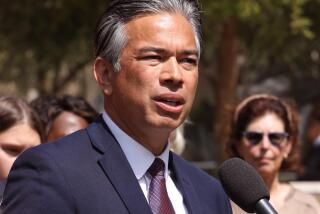Neighborhood councils’ success limited
- Share via
Seven years after a network of neighborhood councils was created to give Los Angeles residents a greater voice in city politics, the groups’ effectiveness remains blunted by infighting, poor community outreach and a lack of influence with key city departments, according to a draft USC report released Saturday.
The councils also do not reflect the ethnic and economic diversity of city residents, and have, in fact, become less diverse over time, researchers from the school’s Civic Engagement Initiative found.
For the record:
12:00 a.m. Dec. 22, 2006 For The Record
Los Angeles Times Friday December 22, 2006 Home Edition Main News Part A Page 2 National Desk 1 inches; 66 words Type of Material: Correction
Neighborhood councils: In an article in Sunday’s California section about the success of neighborhood councils in Los Angeles, Jeff Gardner of the Atwater Village Neighborhood Council said his group had provided a local elementary school with a library. In fact, the library was funded by a grant and school funds. The Atwater council provided a rocking chair and is funding the purchase of additional library books.
These shortcomings have hindered the ability of the city’s 86 neighborhood councils to significantly influence city policy, the report found.
The report was released at a conference at USC.
It is based on surveys of neighborhood council boards in 2003 and 2006 and of City Council staffers and city department administrators. A final report will be issued after neighborhood councils and city leaders provide input.
Juliet Musso, a USC associate professor of public policy and a lead researcher on the report, said one of the councils’ largest obstacles is their difficulty managing conflict, either within their boards or with the myriad groups and businesses they represent.
This infighting hampers their ability to move ahead with basic missions, such as addressing issues important to their communities, recruiting volunteers and developing strong leaders, she said.
Musso said the city needs to provide “ongoing leadership development” to train council members how to run meetings and juggle various viewpoints.
Several neighborhood council members in attendance Saturday agreed that squabbling on their boards has stymied efforts to be more effective.
Gary Baratta, a member of the Mid-Town North Hollywood Neighborhood Council, said his group is splitting into two bodies because the size of its 23-member board and its constituency of 80,000 made it unwieldy and unresponsive to its communities.
“You get 23 or more and they can’t agree that the sun’s coming up yellow in the morning,” he said.
Coming to any decision, he added, is “glacially slow.”
Charlotte Laws, a three-year member of the Greater Valley Glen Neighborhood Council, said her board has been plagued by infighting for the last eight months -- nearly all of it personality driven.
She supports having dispute resolution committees to help councils overcome such roadblocks.
The report found that participation in the councils has fallen over time and board members themselves have become discouraged with their progress. Voters approved the system of councils in 1999 to advise city officials on local matters.
Diversity also remains an issue, with board members more likely to be white and highly educated than the average person in Los Angeles. The study found that the number of board members with post-graduate degrees grew from 35% in 2003 to 40% in 2006.
Musso said city department administrators cited this lack of diversity as one reason they don’t consider the councils important.
“They perceive that [the councils] didn’t necessarily represent the diversity of interests in their neighborhoods,” she said.
Representatives of several neighborhood councils said the study’s findings show predictable growing pains for any organization starting from scratch.
Some members pointed to ways their groups had benefited their neighborhoods in concrete ways.
Jeff Gardner of the Atwater Village council said his group provided supplies to two local elementary schools, including a new library for one.
And Jay Goldberg, formerly a board member of the Toluca Lake council, said his group has been very effective in alerting developers to the concerns of the community.
City Councilman Tom LaBonge, who represents the area, “has used us as a buffer,” he said. “He has told the developers, ‘Before you bring anything to my office, take it to the neighborhood council.’ ”
*
More to Read
Sign up for Essential California
The most important California stories and recommendations in your inbox every morning.
You may occasionally receive promotional content from the Los Angeles Times.










